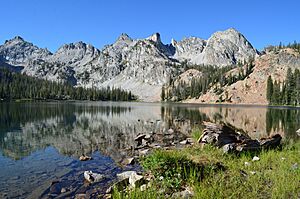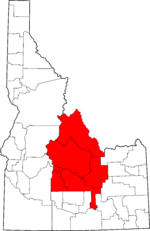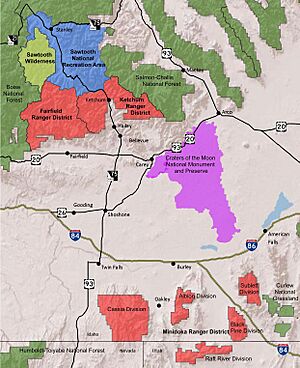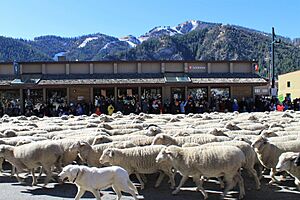Central Idaho facts for kids
Quick facts for kids
Central Idaho
|
|
|---|---|
|
Region
|
|

Alice Lake in the Sawtooth National Recreation Area in Blaine County.
|
|

Map of counties included in Central Idaho (highlighted in red).
|
|
| Country | |
| State | |
| Largest city | Hailey (pop.: 8,689) |
| Area | |
| • Total | 15,434.3 sq mi (39,975 km2) |
| Population
(2020)
|
|
| • Total | 40,172 |
| • Density | 2.6/sq mi (1.0/km2) |
| Time zone | UTC−7 (Mountain) |
| • Summer (DST) | UTC−6 (MDT) |
| Area code(s) | 208, 986 |
Central Idaho is a special part of the state of Idaho. It's found northeast of Boise and southeast of Lewiston. Most of this area is made up of lands managed by the United States Forest Service and the Bureau of Land Management. These are government groups that help take care of our natural spaces.
Idaho's tallest mountain, Borah Peak, stands tall in Central Idaho. You'll also find a big part of the Sawtooth National Recreation Area here, which is a beautiful place for outdoor fun. This region includes five counties: Blaine, Butte, Camas, Custer, and Lemhi. The southern part, especially Blaine and Camas counties, is also called the Wood River Valley. This name comes from the Big Wood River that flows through it.
Contents
People and Towns in Central Idaho
In 2020, about 40,172 people lived in Central Idaho. This is only a small part of Idaho's total population. Some counties like Camas, Butte, and Custer have very few residents, less than 5,000 each. This makes Central Idaho one of the least populated areas in the state.
The biggest town in Central Idaho is Hailey, located in Blaine County. It has about 8,689 people. Other important towns include Stanley, Challis, Salmon, Fairfield, and Arco.
A Look at Central Idaho's Past
Central Idaho has been home to people for at least 12,000 years. Native American tribes like the Northern Shoshone, Bannock, and Northern Paiute lived here. They relied on the yearly runs of sockeye salmon for food. As more people moved west into the United States, these tribes were sadly forced from their homes in the late 1800s. However, some traditional hunting and gathering continued in parts of the Sawtooths.
After the Native Americans were moved, Idaho's economy grew with farming, logging, and mining. Silver mining became very popular in Central Idaho. Later, in the early 1900s, sheepherding became a major industry. Many immigrants from places like Basque Country, Peru, and Scotland came to work as shepherds. At one point, there were over 300,000 sheep in the area!
Even though Central Idaho was used for industries like mining and herding, people also enjoyed it for fun activities. These included camping, fishing, and hunting. Early in the 1900s, there were ideas to create a Sawtooth National Park. But this plan was stopped by World War I. The idea came up again in 1935, but some industry leaders and the U.S. Forest Service didn't want to lose control of the land.
An interesting fact about Central Idaho is that Arco, Idaho was the first city in the United States to get all its power from nuclear power. On July 17, 1955, electricity from an experimental nuclear reactor powered the entire city for over an hour.
In 1960, U.S. Senator Frank Church from Idaho worked to protect the area. This led to the idea of a "National Recreation Area." This way, the Forest Service could still manage the land. At the same time, a company wanted to mine for a metal called molybdenum in the area. Many Idaho citizens strongly opposed this. After much discussion, a large part of Central Idaho was protected by the 1972 Sawtooth NRA Act. This law helps protect the area's wild lands, fish, and animals from too much building and development.
Today, sheepherding is still important in Central Idaho, along with outdoor recreation. The area remains mostly empty because of its mountains, environmental protections, and limited roads.
Central Idaho has also been the starting point for several earthquakes. This is because of its active geology. On March 31, 2020, a 6.5 magnitude earthquake struck the area. A similar strong earthquake happened in 1983.
Central Idaho's Culture
People who live in Central Idaho often value the area's history of industry and its amazing natural resources.

Both locals and visitors love to enjoy the outdoors here. In the summer, popular activities include hiking, backpacking, mountain biking, white water rafting, and kayaking. In winter, people enjoy skiing, snowboarding, snowshoeing, and visiting hot springs. Hunting, fishing, trapping, and camping are also common.
Ghost towns are a cool part of Central Idaho's culture. Bayhorse, Idaho is a ghost town in Custer County. It started as a gold mine, then became a silver mine. But when silver prices dropped, the town was slowly left empty. Today, it's on the National Register of Historic Places and is open for people to visit. Another ghost town, Shoup, Idaho, also shows off the area's mining past. It has old gas pumps and a general store that are kept as historical sites.
The Trailing of the Sheep Festival in Ketchum, Idaho, started in 1996. It celebrates over 150 years of sheepherding and the rich culture that immigrants brought to the area. At the festival, you can take classes on cooking lamb or working with wool. There are also stories about shepherds and demonstrations of dogs herding sheep. A highlight is a parade of sheep walking right through downtown Ketchum!
The Sawtooth Salmon Festival began in 2000. It's held at the Stanley Museum in Stanley every August. This festival celebrates when salmon swim upstream to lay their eggs in the Salmon River. It features live entertainment, educational tours, food, and vendors.
The Sawtooth Festival, created in 2021, is held in July, also in Stanley. This festival helps raise money and supports local businesses and the community. It features arts and crafts from over 80 artists from Stanley and the Central Idaho area. You can find photographers, painters, potters, jewelers, crocheters, and macrame artists. Live music, food, and drinks are also available.
Towns and Cities



